Abstract
Here we report the expression cloning of cDNA encoding a putative opioid receptor from a human placenta cDNA library. Placental opioid receptors are of the kappa type. As the dynorphin opioid peptides are kappa-selective, a dynorphin ligand was used in an affinity-enrichment (panning) procedure to select transiently transfected COS-7 cells expressing kappa receptor binding sites. The cloned cDNA encodes a 440-residue protein of the seven-helix guanine nucleotide-binding protein (G-protein)-coupled receptor family. Ligand binding reveals a stereospecific site with typical opioid properties, which binds peptide and nonpeptide opioids with moderate affinity (Kd approximately 100 nM) and which lacks the expected kappa selectivity. The deduced transmembrane domain is 93% identical to the homologous region of the human neuromedin K (neurokinin B) receptor, but the N-terminal and C-terminal sequences have many dissimilarities. The expressed receptor binds opioid ligands but not tachykinins; and under the same conditions, a cloned rat neuromedin K receptor binds tachykinins but not opioids.
Full text
PDF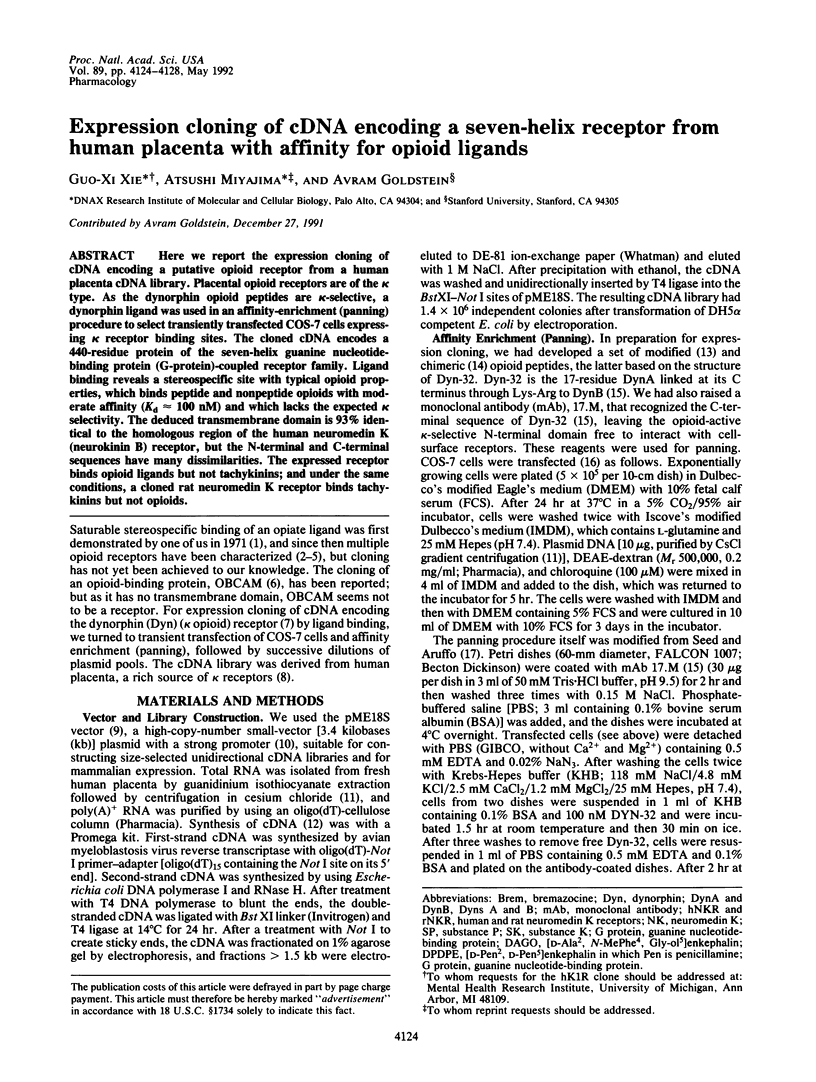
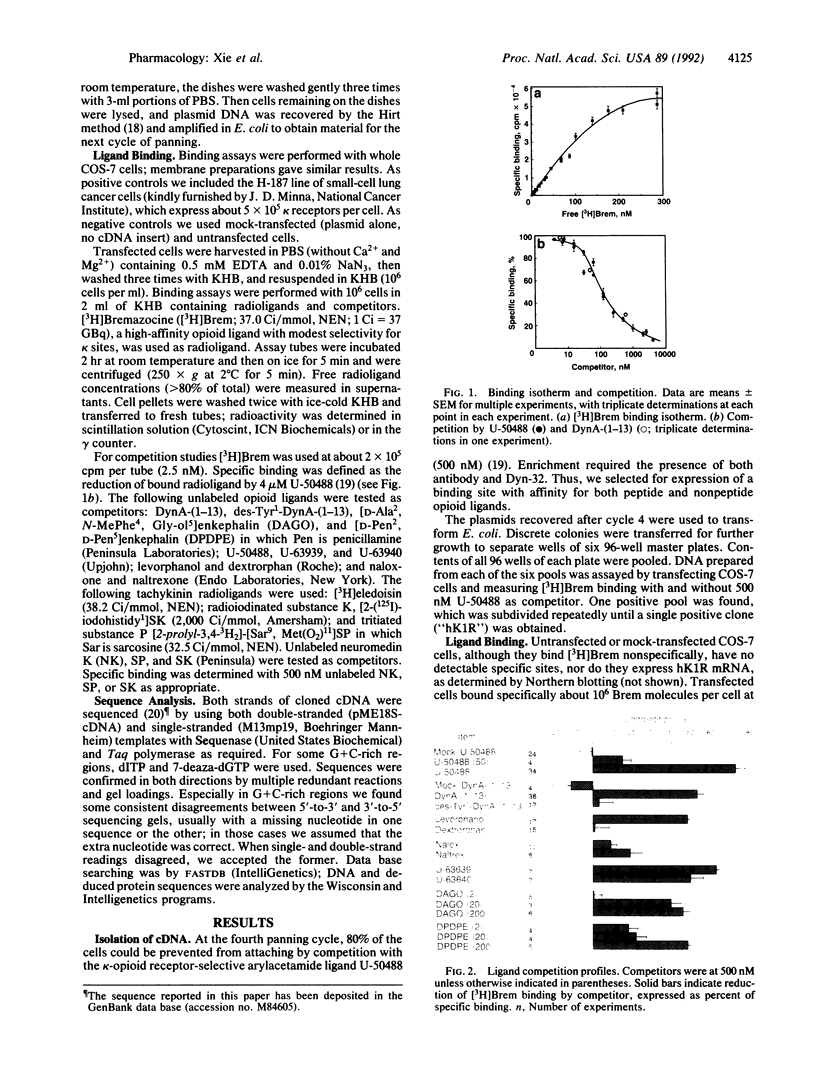
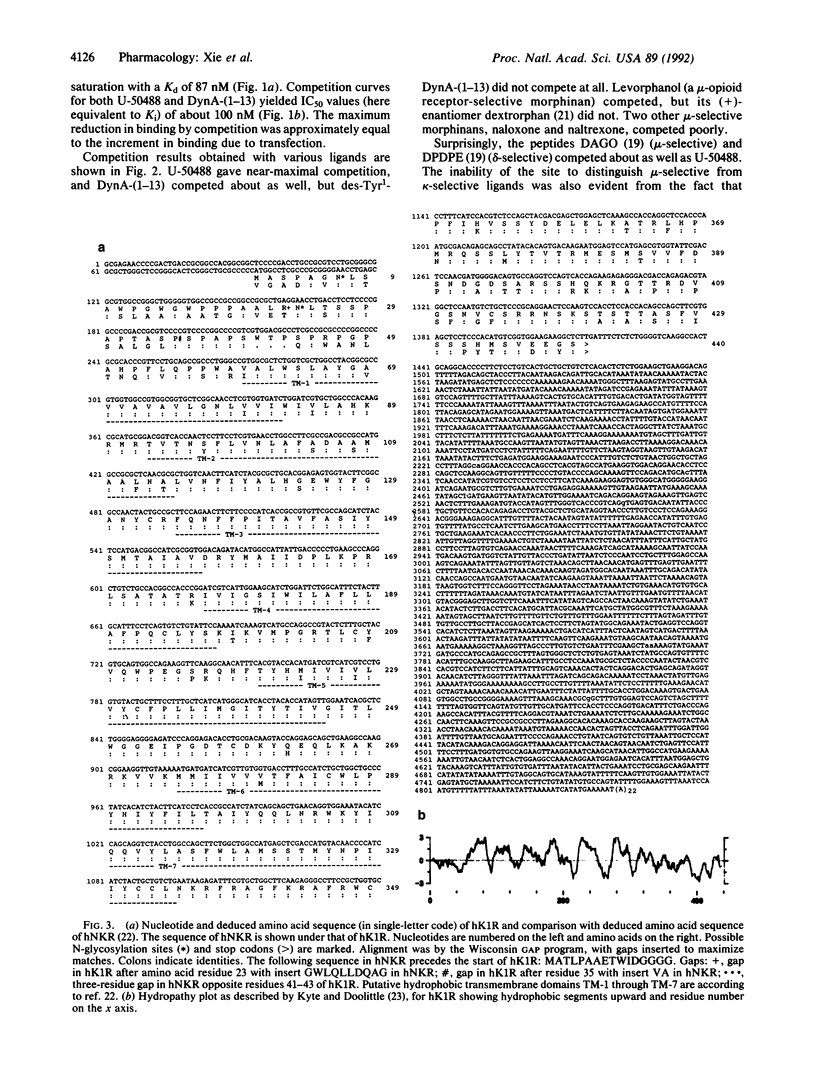
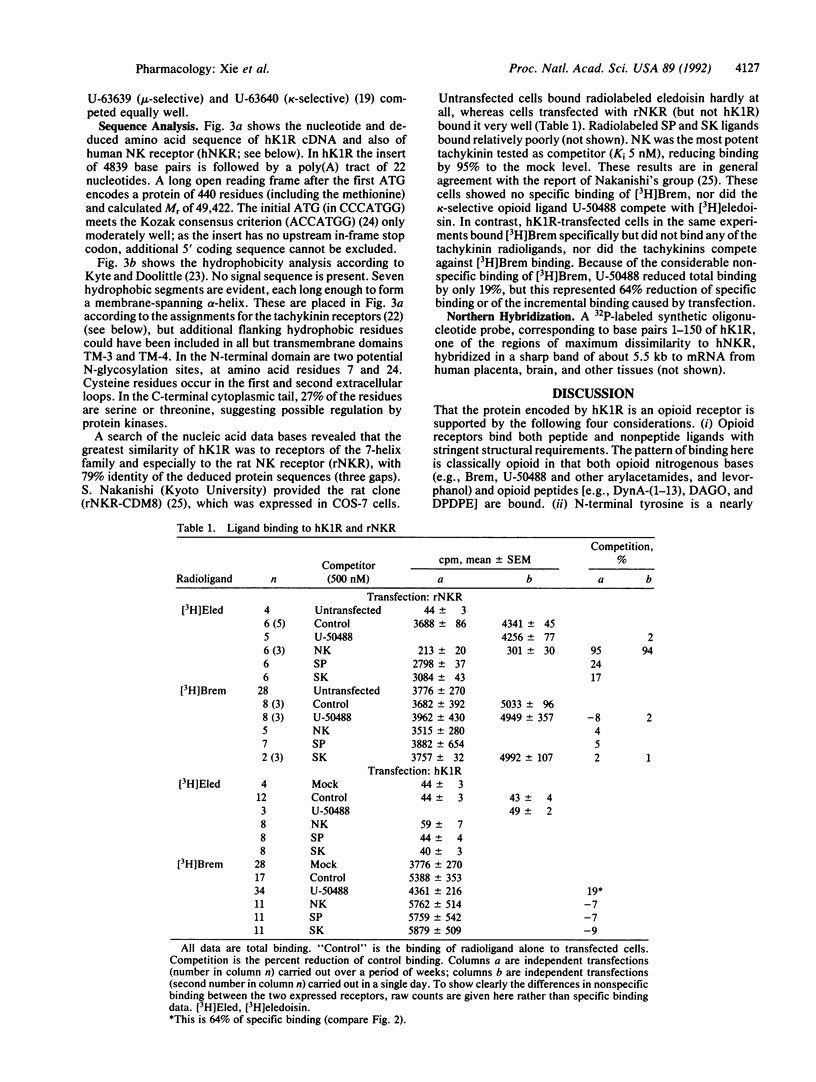
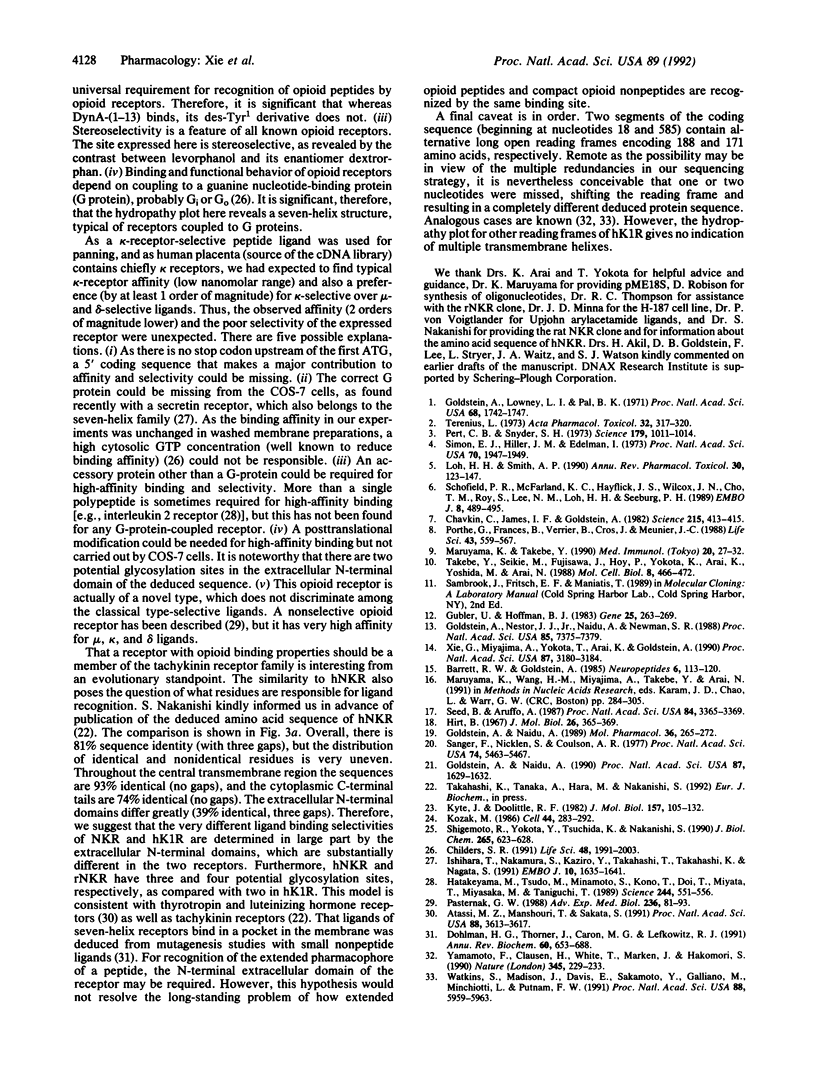
Images in this article
Selected References
These references are in PubMed. This may not be the complete list of references from this article.
- Atassi M. Z., Manshouri T., Sakata S. Localization and synthesis of the hormone-binding regions of the human thyrotropin receptor. Proc Natl Acad Sci U S A. 1991 May 1;88(9):3613–3617. doi: 10.1073/pnas.88.9.3613. [DOI] [PMC free article] [PubMed] [Google Scholar]
- Barrett R. W., Goldstein A. A monoclonal antibody specific for a dynorphin precursor. Neuropeptides. 1985 Apr;6(2):113–120. doi: 10.1016/0143-4179(85)90102-7. [DOI] [PubMed] [Google Scholar]
- Chavkin C., James I. F., Goldstein A. Dynorphin is a specific endogenous ligand of the kappa opioid receptor. Science. 1982 Jan 22;215(4531):413–415. doi: 10.1126/science.6120570. [DOI] [PubMed] [Google Scholar]
- Childers S. R. Opioid receptor-coupled second messenger systems. Life Sci. 1991;48(21):1991–2003. doi: 10.1016/0024-3205(91)90154-4. [DOI] [PubMed] [Google Scholar]
- Dohlman H. G., Thorner J., Caron M. G., Lefkowitz R. J. Model systems for the study of seven-transmembrane-segment receptors. Annu Rev Biochem. 1991;60:653–688. doi: 10.1146/annurev.bi.60.070191.003253. [DOI] [PubMed] [Google Scholar]
- Goldstein A., Lowney L. I., Pal B. K. Stereospecific and nonspecific interactions of the morphine congener levorphanol in subcellular fractions of mouse brain. Proc Natl Acad Sci U S A. 1971 Aug;68(8):1742–1747. doi: 10.1073/pnas.68.8.1742. [DOI] [PMC free article] [PubMed] [Google Scholar]
- Goldstein A., Naidu A. Dextrorphan binds to opioid receptors in guinea-pig brain membranes and is an antagonist at opioid receptors in myenteric plexus. Proc Natl Acad Sci U S A. 1990 Mar;87(5):1629–1632. doi: 10.1073/pnas.87.5.1629. [DOI] [PMC free article] [PubMed] [Google Scholar]
- Goldstein A., Naidu A. Multiple opioid receptors: ligand selectivity profiles and binding site signatures. Mol Pharmacol. 1989 Aug;36(2):265–272. [PubMed] [Google Scholar]
- Goldstein A., Nestor J. J., Jr, Naidu A., Newman S. R. "DAKLI": a multipurpose ligand with high affinity and selectivity for dynorphin (kappa opioid) binding sites. Proc Natl Acad Sci U S A. 1988 Oct;85(19):7375–7379. doi: 10.1073/pnas.85.19.7375. [DOI] [PMC free article] [PubMed] [Google Scholar]
- Gubler U., Hoffman B. J. A simple and very efficient method for generating cDNA libraries. Gene. 1983 Nov;25(2-3):263–269. doi: 10.1016/0378-1119(83)90230-5. [DOI] [PubMed] [Google Scholar]
- Hatakeyama M., Tsudo M., Minamoto S., Kono T., Doi T., Miyata T., Miyasaka M., Taniguchi T. Interleukin-2 receptor beta chain gene: generation of three receptor forms by cloned human alpha and beta chain cDNA's. Science. 1989 May 5;244(4904):551–556. doi: 10.1126/science.2785715. [DOI] [PubMed] [Google Scholar]
- Hirt B. Selective extraction of polyoma DNA from infected mouse cell cultures. J Mol Biol. 1967 Jun 14;26(2):365–369. doi: 10.1016/0022-2836(67)90307-5. [DOI] [PubMed] [Google Scholar]
- Ishihara T., Nakamura S., Kaziro Y., Takahashi T., Takahashi K., Nagata S. Molecular cloning and expression of a cDNA encoding the secretin receptor. EMBO J. 1991 Jul;10(7):1635–1641. doi: 10.1002/j.1460-2075.1991.tb07686.x. [DOI] [PMC free article] [PubMed] [Google Scholar]
- Kozak M. Point mutations define a sequence flanking the AUG initiator codon that modulates translation by eukaryotic ribosomes. Cell. 1986 Jan 31;44(2):283–292. doi: 10.1016/0092-8674(86)90762-2. [DOI] [PubMed] [Google Scholar]
- Kyte J., Doolittle R. F. A simple method for displaying the hydropathic character of a protein. J Mol Biol. 1982 May 5;157(1):105–132. doi: 10.1016/0022-2836(82)90515-0. [DOI] [PubMed] [Google Scholar]
- Loh H. H., Smith A. P. Molecular characterization of opioid receptors. Annu Rev Pharmacol Toxicol. 1990;30:123–147. doi: 10.1146/annurev.pa.30.040190.001011. [DOI] [PubMed] [Google Scholar]
- Pasternak G. W. Studies of multiple morphine and enkephalin receptors: evidence for mu1 receptors. Adv Exp Med Biol. 1988;236:81–93. doi: 10.1007/978-1-4757-5971-6_7. [DOI] [PubMed] [Google Scholar]
- Pert C. B., Snyder S. H. Opiate receptor: demonstration in nervous tissue. Science. 1973 Mar 9;179(4077):1011–1014. doi: 10.1126/science.179.4077.1011. [DOI] [PubMed] [Google Scholar]
- Porthé G., Francés B., Verrier B., Cros J., Meunier J. C. The kappa-opioid receptor from human placenta: hydrodynamic characteristics and evidence for its association with a G protein. Life Sci. 1988;43(6):559–567. doi: 10.1016/0024-3205(88)90159-2. [DOI] [PubMed] [Google Scholar]
- Sanger F., Nicklen S., Coulson A. R. DNA sequencing with chain-terminating inhibitors. Proc Natl Acad Sci U S A. 1977 Dec;74(12):5463–5467. doi: 10.1073/pnas.74.12.5463. [DOI] [PMC free article] [PubMed] [Google Scholar]
- Schofield P. R., McFarland K. C., Hayflick J. S., Wilcox J. N., Cho T. M., Roy S., Lee N. M., Loh H. H., Seeburg P. H. Molecular characterization of a new immunoglobulin superfamily protein with potential roles in opioid binding and cell contact. EMBO J. 1989 Feb;8(2):489–495. doi: 10.1002/j.1460-2075.1989.tb03402.x. [DOI] [PMC free article] [PubMed] [Google Scholar]
- Seed B., Aruffo A. Molecular cloning of the CD2 antigen, the T-cell erythrocyte receptor, by a rapid immunoselection procedure. Proc Natl Acad Sci U S A. 1987 May;84(10):3365–3369. doi: 10.1073/pnas.84.10.3365. [DOI] [PMC free article] [PubMed] [Google Scholar]
- Shigemoto R., Yokota Y., Tsuchida K., Nakanishi S. Cloning and expression of a rat neuromedin K receptor cDNA. J Biol Chem. 1990 Jan 15;265(2):623–628. [PubMed] [Google Scholar]
- Simon E. J., Hiller J. M., Edelman I. Stereospecific binding of the potent narcotic analgesic (3H) Etorphine to rat-brain homogenate. Proc Natl Acad Sci U S A. 1973 Jul;70(7):1947–1949. doi: 10.1073/pnas.70.7.1947. [DOI] [PMC free article] [PubMed] [Google Scholar]
- Takebe Y., Seiki M., Fujisawa J., Hoy P., Yokota K., Arai K., Yoshida M., Arai N. SR alpha promoter: an efficient and versatile mammalian cDNA expression system composed of the simian virus 40 early promoter and the R-U5 segment of human T-cell leukemia virus type 1 long terminal repeat. Mol Cell Biol. 1988 Jan;8(1):466–472. doi: 10.1128/mcb.8.1.466. [DOI] [PMC free article] [PubMed] [Google Scholar]
- Terenius L. Stereospecific interaction between narcotic analgesics and a synaptic plasm a membrane fraction of rat cerebral cortex. Acta Pharmacol Toxicol (Copenh) 1973;32(3):317–320. doi: 10.1111/j.1600-0773.1973.tb01477.x. [DOI] [PubMed] [Google Scholar]
- Watkins S., Madison J., Davis E., Sakamoto Y., Galliano M., Minchiotti L., Putnam F. W. A donor splice mutation and a single-base deletion produce two carboxyl-terminal variants of human serum albumin. Proc Natl Acad Sci U S A. 1991 Jul 15;88(14):5959–5963. doi: 10.1073/pnas.88.14.5959. [DOI] [PMC free article] [PubMed] [Google Scholar]
- Xie G. X., Miyajima A., Yokota T., Arai K., Goldstein A. Chimeric opioid peptides: tools for identifying opioid receptor types. Proc Natl Acad Sci U S A. 1990 Apr;87(8):3180–3184. doi: 10.1073/pnas.87.8.3180. [DOI] [PMC free article] [PubMed] [Google Scholar]
- Yamamoto F., Clausen H., White T., Marken J., Hakomori S. Molecular genetic basis of the histo-blood group ABO system. Nature. 1990 May 17;345(6272):229–233. doi: 10.1038/345229a0. [DOI] [PubMed] [Google Scholar]



